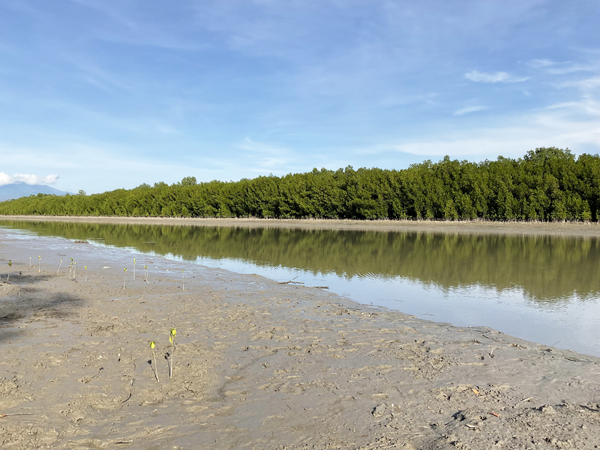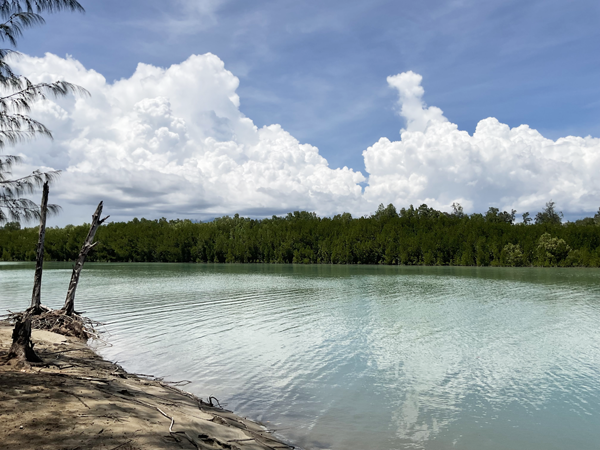The Story of Fesawa River and Fesawa Crocodiles in Kamanasa, Suai
Long ago, an ancient village called Benabu Wen was located in Fesawa. A King named Lihuwa’i and a Queen named Feto Sawa reigned this ancient traditional kingdom for thousands of years until an unknown natural disaster destroyed the town and turned it into a massive cove called Fesawa. The catastrophe washed the entire village into the ocean and swallowed some inhabitants. It is a traumatic and terrible disaster that will affect your life forever. Those who survived the tragedy would never return and live in the area. They had no choice but to abandon the ruined village and look for a safer place to live so they could get on with their lives.
The Tetun Fehan cultural groups were the original inhabitants of Benabu Wen village. Alongside their monarchs, they established the town and adhered to the customs and traditions of the Tetun community. Their way of life was simple, residing in basic traditional dwellings similar to those in Kamanasa today. They constructed their homes using wood, bamboo, and palm materials. Additionally, they engaged in agricultural activities by cultivating rice and corn, raising livestock, including cattle, buffaloes, pigs, and horses, and fishing. Importantly, they crafted Tais (traditional garments) to protect themselves from heat and cold. The residents of Benabu Wen enjoyed a lifestyle much like other ethnic groups on Timor Island until an unfortunate event dramatically altered their existence.
Lihuwa’i and Feto Sawa were blessed with two delightful princesses: Princess Rika Lihuwa’i and Princess Dahu Lihuwa’i. These two lovely princesses would eventually wed a dashing local prince or a prince from another culture on Timor Island. They thoroughly enjoyed their lives and mingled easily with the everyday people in their community. Like other women of Fehan, they were passionate about Soru Tais (the art of weaving traditional garments). As previously mentioned, they grew cotton on their To’os (farmland) and utilised traditional wooden tools they had designed to transform raw cotton into threads.

According to legend, a prince of Tafara and a prince of Sumaen wanted to marry two charming princesses of Lihuai. The two princesses rejected their requests and said to them, "Ami la hola na'n Tafara ibun mafarak, no ami la hola na'n Sumaen ain tanen maal". It means that we would never get married to a Tafara prince who had a dirty mouth, and we would never get married to a Sumaen prince who had thick feet. The two princes reacted to this and said to the princesses, "All right, we will send a deluge to destroy your village. The two princesses said to them, "You could send a flood or whatever to destroy the town, and we would not run away from this village; we would rather die here. Then they sent the flood to destroy the town. As the flood approached the village, people started to panic and run away to save their lives, but the two princesses did not run away from their house; they kept weaving Tais until the flood swallowed them up, and they died. Their bodies turned into a couple of crocodiles. The flood swept through the village, killing its residents and creating a massive river called the Fesawa River. So, the Fesawa River was born out of the Lihuai village.
How did Princes Sumaen and Tafara orchestrate the flood? On 30 November 2024, I spoke with a knowledgeable Lia Na’in (traditional chief) from the Fatuisin Hamlet in Kamanasa, who fervently shared the tale of how the two princes devised the flood. As I noted previously in the chapter about traditional beliefs, many ancient Na’in (nobles) and Liurai (kings) were said to wield a formidable magic known as Vertude. Thus, Prince Sumaen and Tafara employed this powerful magic to engineer the flood. They petitioned the supernatural for rainfall. Once the rain began to fall, they dammed all the rivers to allow the water to accumulate like a vast reservoir. The rainwater remained stagnant because they obstructed its flow until it nearly engulfed the mountains. Eventually, the rain ceased, and they unleashed the water, transforming into a flood that swept away Benabu Wen. How did they manage to obstruct the water? Did they utilise sand and stones? The truth is, it remains a mystery!
To gather more information about Fesawa Cove and discover details regarding the river that leads into it, I sent Nahak and two of his friends to Fesawa Cove on 30 November 2024 to capture some photographs and videos. Using my iPad, Nahak took numerous pictures and several video clips. I carefully reviewed the images and viewed the videos. They revealed no evidence of a river flowing from the mountains into the cove. Therefore, I concluded that Fesawa is not a river but a moderately sized cove or coastal inlet. It is a long, narrow bay that extends inland from the ocean for approximately 2000 metres. During low tide, the water in the cove recedes to about one meter deep, while at high tide, the cove brims with seawater. Consequently, the only water entering Fesawa Cove is seawater—no rivers feed into it. Hence, it seems that Mother Nature formed both Fesawa and Maubesi in West Timor simultaneously, likely during rising sea levels around 11,000 years ago.
Several decades after the destruction, a man named Fatu Bisi from Fatuisun hunted around the Fesawa Cove. When he walked along the riverbank, he saw two lovely female crocodiles. They were half crocodile and half human. He was astonished and thrilled when he saw the two baby crocodiles. He believed the crocodiles were the two princesses who vanished in the tragic catastrophe. He decided to take the baby crocodiles home. He carried them from the Fesawa Cove to the hamlet of Fatuisin in Kamanasa village.

When Fatu Bisi and the two baby crocodiles arrived in Kamanasa, the whole community was surprised and rushed to see the crocodiles. The community welcomed them and provided them with a special place to live. The two crocodiles were raised and lived in Fatuisin for a considerable time.
Because the crocodiles had tails, they lived only in the house. They avoided socialising and sharing things with others. They felt embarrassed that they had tales. Therefore, they requested that Fatu Bisi and the community return them to the Fesawa River. He took them back to their natural habitat. They began to live as crocodiles in the Fesawa River, and their descendants still live there today.
Kesi Tali Matak refers to attaching a piece of green palm leaves to your head. It is a sign that tells the crocodiles living in the Fesawa River that you are their progeny. To avoid trouble, you must tie a green knot on your head before entering the water because other crocodiles have migrated to the river.
Another story I heard from my mother, Rika Kehik, says that every time Kamanasa people went fishing at the Fesawa River, the spirits of those who died in the tragedy always caught a deer for them. Whenever people went to the river, they would always see a deer tied to a tree. It is an unbelievable story and beyond human comprehension. That is how prehistoric people attempted to comprehend Mother Nature by creating legends and myths to share with their children and grandchildren.
When you look at the size of the river, one can tell that there must have been a massive catastrophe that destroyed the whole village and killed some of the villagers, including the princesses. A flood alone would not turn the village into this vast river. Other natural disasters, such as volcanic eruptions, earthquakes, rising sea levels, or intense cyclones, could cause the sea to flood the village. Whatever the cause of the destruction, Lihuai had disappeared and left nothing but the river — Fesawa and the crocodiles in it.
Fesawa Cove is the biggest river bank in Suai Covalima. The locals consider it a Lulik (sacred) river, and it is home to the spirits or souls of those who vanished in the tragic catastrophe. The river is also considered a loving place for the two princesses who transformed into two crocodiles and their crocodile descendants, who live in the river today.
Whether you believe it or not, the Kamanasa people have worshipped Fesawa for thousands of years. They regard it as a sacred river (Lulik) and a resting place for their ancient ancestors, especially the crocodiles living in the river today. They have known the river for about ten thousand years. So, we should respect their beliefs and preserve the river for the future generations of Kamanasa and Raimea. Any future development around the river should not damage or threaten the lives of the crocodiles because they are the ancestors of the Kamanasa and Raimea people.
That's how the people of Kamanasa perceive the river Fesawa, creating myths and legends to understand Mother Nature.
The sole method to demonstrate that Benabu Wen village was present earlier is to excavate the cove to uncover artifacts and potentially human remains concealed beneath the soil. Even if artifacts are discovered, we can still dismiss the flood caused by Prince Sumaen and Tafara, as early humans could not certainly produce rain, floods, or any other natural phenomena.
